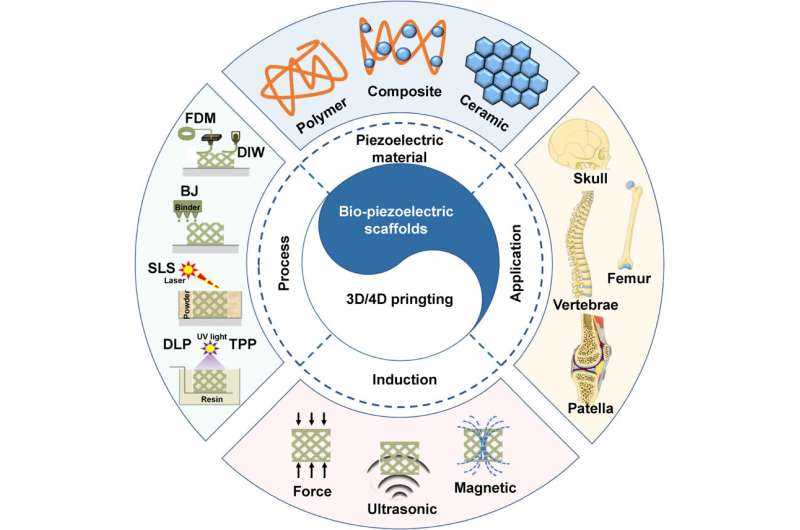This article has been reviewed according to Science X's editorial process and policies. Editors have highlighted the following attributes while ensuring the content's credibility:
fact-checked
proofread
3D/4D printed bio-piezoelectric scaffolds show potential in bone tissue engineering

Piezoelectricity has been well recognized as the key factor in bone regeneration. However, the current additive-manufactured scaffolds mainly focus on the reconstruction of bionic topological structure and mechanical microenvironment, while the crucial electrical microenvironment (EM) in bone regeneration is neglected.
The research, published in International Journal of Extreme Manufacturing , shows the enormous potential of 3D/4D printing of bio-piezoelectric scaffolds for next-generation bone tissue engineering.
There is a significant gap between the capabilities of the current 3D/4D printing techniques and the clinical application requirements of bio-piezoelectric scaffolds. Its development requires a joint effort of multidisciplinary studies including materials science, mechanical engineering, and bioengineering. Its widespread adoption should also draw inspiration from some cutting-edge technologies such as intelligent manufacturing, bionic medicine, and machine learning.
"In principle, this opens up the design and fabrication of a smart biological piezoelectric scaffold that promotes bone repair by mimicking the tissue's crucial electrical microenvironment," said Annan Chen a postdoctoral fellow at the City University of Hong Kong and the first author on the study.
"Essentially, it offers new enlightenment toward a potential breakthrough in building smart scaffolds for next-generation bone tissue engineering," said Prof. Chunze Yan, a professor at the Huazhong University of Science Technology, and Prof. Jian Lu, a Chair professor at the City University of Hong Kong.
This piezoelectricity has been demonstrated in human bones, which generate positive and negative charges when subjected to compression or tension. For instance, the human tibia can generate a piezoelectric potential of ~300 μV during walking. Therefore, piezoelectric materials show unique advantages in simulating the EM of bone tissues, which can significantly promote the metabolism of cells and new bone formation.
The surface charges of piezoelectric materials can attract ions to promote cell adhesion through ion or charge interaction, as well as activate growth factor expression to improve cell proliferation and osteogenic differentiation.
The additive-manufactured bio-piezoelectric scaffolds can reconstruct desired tissue EM through a non-invasive ultrasonic stimulation. This time-dependent functionality-shifting behavior of 3D structures when exposed to external stimulus, also is defined as four-dimensional (4D) printing. This new 4D functionality-shifting bio-piezoelectric scaffolds can provide a time-dependent programmable electrophysiological microenvironment in response to external stimuli for tissue regeneration.
Chen began experimenting with some lead-free biological piezoelectric materials that were discovered years ago, but largely ignored. He focused on the material-topography-biofunctionality intergated 3D/4D printing of bio-piezoelectric materials for advanced biological applications.
To the scientists' astonishment, the bio-piezoelectric materials showed excellent processability and biocompatibility. What's more, they were multicellular inducible. "We found that their electrical microenvironment can induce bone cell differentiation, promote vascular cell recruitment and nerve cell repair," said Chen. That shows great potential for clinical applications.
But for clinical medicine, the most striking thing was that the reconstitution strategy of the bio-piezoelectric scaffold was minimally invasive or non-invasive. "Upon programmable ultrasound or magnetic treatment as a remote mechanical stimulus, the on-demand in vivo electrical stimulation with an adjustable timeline, duration, and strength can be delivered," said Yan.
Chen, Yan, Lu, and their lab worked with other scientists around the university to try to combine the advantages of multiple disciplines to promote the 3D/4D smart piezoelectric biological scaffolds in more medical applications. "We are carrying out cooperative research with experts in orthopedics, stomatology, oncology and other fields, and achieved the expected research results," said Chen.
Over the years, 3D/4D printing technology has incorporated many advantages observed in traditional production techniques. Although it is still a long way to go from bench side to bedside, the team expresses optimism about the future of 3D/4D printing. "The 3D/4D printing of bio-piezoelectric scaffolds fully integrates the benefits of multiple disciplines such as materials science, mechanical engineering, and bioengineering, its great development requires a multidisciplinary joint effort," said Professor Lu.
"With the collaborative efforts of multidisciplinary studies, 3D/4D printing would be expected to soon reach its full potential in creating smart bio-piezoelectric scaffolds for next-generation tissue engineering. Besides, we also can draw inspiration from some cutting-edge technologies such as intelligent manufacturing, bionic medicine, and machine learning, to further promote the clinical application of this technology."
More information: Annan Chen et al, 3D/4D printed bio-piezoelectric smart scaffolds for next-generation bone tissue engineering, International Journal of Extreme Manufacturing (2023). DOI: 10.1088/2631-7990/acd88f
Provided by International Journal of Extreme Manufacturing





















